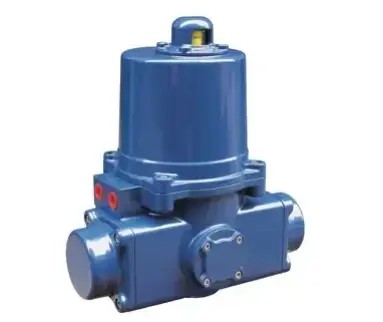Introduction
In industrial and automated systems, ensuring the safety and proper functionality of equipment during power failures is crucial. Spring return electric actuators are key components designed to automatically return China Control Valves or other equipment to a preset "safe" position—such as fully open or fully closed—when power is lost. Utilizing an internal spring storage mechanism, these actuators provide a reliable, fail-safe solution, especially in emergency situations. This article explores the mechanics, types, applications, and differences between spring return and double-acting electric actuators.
What Is a Spring Return Electric Actuator?
A spring return electric actuator is a device that uses a spring mechanism to automatically return connected equipment to a predefined position during a power outage. This automatic resetting feature is invaluable in applications where human intervention is either impractical or too risky. The actuator ensures that the system responds predictably by moving to a safe state—either open or closed—when power is lost, making it a critical safety component in various industrial environments.
Actuators in general convert energy into mechanical motion, enabling control over equipment like valves, dampers, and other mechanical devices. Spring return actuators are specifically designed with a built-in spring that compresses during normal operation. Upon power loss, the spring releases its stored energy, moving the valve or equipment back to the safe position.
How Does a Spring Return Actuator Work?
To understand a spring return actuator, it helps to first consider the general principle of actuators. These devices use an external energy source—electric, pneumatic, or hydraulic power—to move mechanical components like valves or dampers. Electric actuators are commonly used in many industrial applications and can be controlled manually or automatically via control signals.
In spring return actuators, the critical feature is the internal spring. When powered, the actuator compresses the spring while moving the valve to the desired position. If power is lost, the spring automatically expands, forcing the actuator to return the valve or equipment to a preset "safe" position. This fail-safe mechanism prevents uncontrolled states that could cause damage or hazards.
The actuator is usually coupled to a valve that regulates fluid or gas flow. In power failure scenarios, the spring provides the force needed to safely reposition the valve without requiring electrical power, making spring return actuators especially suitable for emergency shut-off applications.
Key Features of Spring Return Electric Actuators
- Fail-Safe Operation: Automatically moves to a predefined safe position during power failure.
- Simple Design: Uses a spring for return force, minimizing complexity and increasing reliability.
- Low Power Consumption: No power needed to maintain the safe position once the spring is released.
- Automated Control: Can integrate with control systems for enhanced automation and safety.
Types of Actuators: Spring Return vs. Double Acting
Spring Return Actuators
- Operation: Air or liquid pressure moves the actuator in one direction during normal operation; an internal spring returns it to the safe position when power or pressure is lost.
- Applications: Safety-critical systems like emergency shutdown valves, pressure relief valves, and fail-safe equipment.
- Advantages: Simple, robust, cost-effective, and highly reliable for fail-safe needs.
Double Acting Actuators
- Operation: Air or liquid pressure is applied alternately to both sides of the piston, enabling powered movement in both directions.
- Applications: Systems needing precise control and high torque in both open and close directions, common in oil & gas, petrochemical, and heavy manufacturing.
- Advantages: High torque capability, precise valve positioning, suitable for large, complex valves.
Differences Between Spring Return and Double Acting Actuators
FeatureSpring Return ActuatorDouble Acting ActuatorDesign ComplexitySimpler, fewer componentsMore complex, requires dual pressureTorque CapabilityLower torque, single directionHigh torque in both directionsFail-Safe FunctionalityBuilt-in fail-safe to safe positionNo inherent fail-safe; stays in last positionTypical ApplicationsEmergency shutdowns, safety valvesPrecise control, heavy-duty industrial valves
Spring-Return Actuator vs. Non-Spring Return Actuator
Spring-Return Actuator (Fail-Safe)
- Has a built-in spring mechanism that moves the actuator to a default safe position during signal or power loss.
- Ideal for safety-critical environments such as fire protection, emergency shutdowns, and ventilation systems.
Non-Spring Return Actuator (Direct Drive)
- Requires continuous power or signal to maintain position.
- Remains in last commanded position if power is lost.
- Suitable where fail-safe operation is not critical but position holding is necessary.
- Often includes position feedback for real-time monitoring.
Applications of Spring Return Electric Actuators
- Emergency Shutoff Valves: Quickly stop flow to prevent accidents during emergencies.
- Fire Protection Systems: Automatically close fire dampers or valves to contain fire spread.
- Pressure Relief Systems: Ensure safe venting of excess pressure during overpressure conditions.
- Water Treatment Plants: Prevent contamination by closing valves during power loss.
- Industrial Automation: Control fluid, gas, or air flow in safety-sensitive manufacturing processes.
Conclusion
In industries where safety, reliability, and automation are paramount, spring return electric actuators provide an essential fail-safe function. By automatically returning to a preset safe position during power failures, they help prevent system damage and protect personnel. While spring return actuators excel in safety-critical and emergency applications, double acting actuators offer precise control and higher torque for complex operations. Selecting the right actuator depends on the specific application’s safety and performance requirements.
With their simple yet effective design, spring return electric actuators remain indispensable components in maintaining operational safety and efficiency across a wide range of industrial sectors worldwide.Know more about Google SEO Directory





Comments